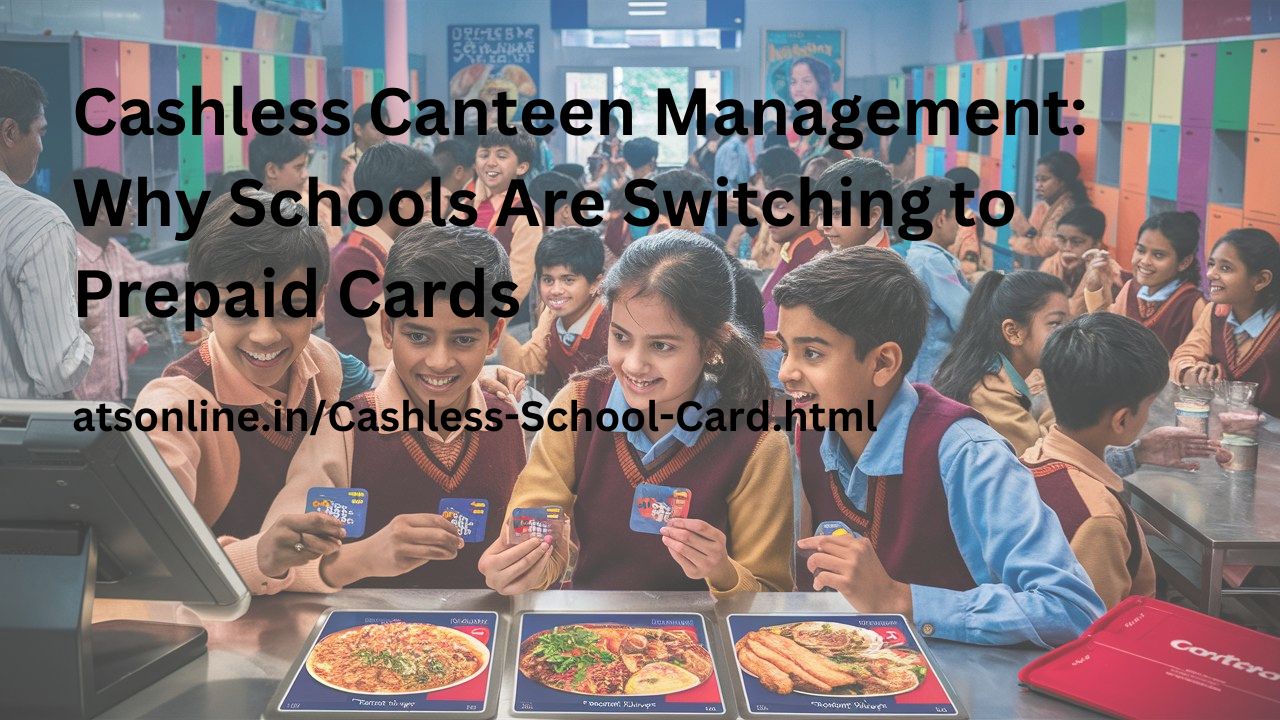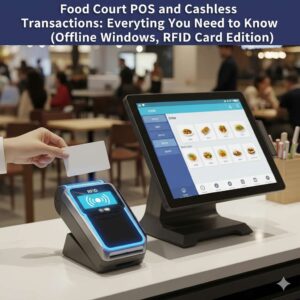The school canteen, a bustling hub of activity during break times, has undergone a significant transformation in recent years. Gone are the days of fumbling for loose change and long queues as a new era of cashless canteen management takes hold. Across the globe, schools are embracing the efficiency and convenience of prepaid cards to revolutionize their canteen operations.
This shift towards a cashless model is driven by a multitude of benefits, impacting not just the administrative processes but also the overall student experience. From streamlining transactions to enhancing security and promoting financial literacy, cashless canteen management offers a compelling solution for modern educational institutions. This article delves into the reasons behind this growing trend, exploring the advantages of prepaid cards for schools, students, and parents alike.
Join us as we uncover the compelling reasons why schools are making the switch to a cashless future, paving the way for a more efficient, secure, and enriching canteen experience for everyone.
Understanding Cashless Canteen Management
Before diving into the benefits, let’s first understand what cashless canteen management entails. In essence, it refers to a system where students make purchases in the canteen using electronic methods instead of physical cash. This eliminates the need for students to carry cash, simplifying transactions and reducing the risk of theft or loss.
Several types of cashless canteen systems exist, each with its own set of features and advantages. These include:
- Prepaid Cards: Students are issued personalized cards that can be preloaded with funds by parents or guardians. These cards are then used to make purchases at the canteen, deducting the cost from the card’s balance.
- Mobile Wallets: Students can use their smartphones or other mobile devices to make payments through digital wallets, such as Apple Pay or Google Pay.
- Biometric Systems: This advanced technology uses unique biometric identifiers, such as fingerprints or facial recognition, to authenticate payments.
While each system offers distinct advantages, prepaid cards have emerged as a particularly popular choice for schools due to their ease of use, affordability, and robust security features. They provide a tangible payment method for students while offering parents and school administrators a convenient way to manage and monitor spending.
The shift towards digital payment solutions in schools reflects a broader societal trend towards a cashless society. According to a report by Allied Market Research, the global digital payments market is expected to reach new heights by 2025, driven by factors such as increased smartphone penetration, growing internet usage, and the rise of e-commerce
Furthermore, the COVID-19 pandemic has accelerated the adoption of contactless payment methods, making cashless canteen management even more appealing for schools seeking to prioritize hygiene and safety.
In the next section, we’ll explore the specific benefits of using prepaid cards in school canteens, examining how they enhance efficiency, security, and the overall student experience.
The Benefits of Prepaid Cards for School Canteens
The adoption of prepaid cards for cashless canteen management brings a wealth of benefits for both schools and students. Let’s break down the advantages for each group:
For Schools:
- Increased Efficiency and Security: Prepaid cards streamline the payment process, significantly reducing transaction times and minimizing queues during peak hours. This increased efficiency translates to more time for students to enjoy their breaks and less time spent waiting in line. Furthermore, by reducing the amount of cash handled in the canteen, schools can minimize the risk of theft and human error, enhancing overall security.
- Improved Accounting and Reporting: With a prepaid card system, schools gain access to detailed transaction data, allowing for accurate and efficient accounting and reporting. This automated tracking simplifies reconciliation processes and provides valuable insights into spending patterns, enabling data-driven decision-making for canteen operations.
- Reduced Administrative Burden: By automating payment processes, prepaid cards free up valuable staff time that would otherwise be spent on cash handling, reconciliation, and administrative tasks. This allows staff to focus on other essential duties, improving overall productivity and efficiency.
- Enhanced Hygiene and Safety: In a post-pandemic world, hygiene and safety are paramount. Contactless payments offered by prepaid cards minimize physical contact, promoting a cleaner and safer canteen environment for both students and staff.
- Better Budget Control for Students: Prepaid cards empower students to manage their own spending, promoting financial responsibility and helping them make informed choices about their food purchases. Parents can also set spending limits and monitor their child’s canteen expenses, ensuring better budget control.
For Students:
- Convenience and Speed: Prepaid cards offer a quick and easy payment method, eliminating the need to fumble for cash or worry about losing money. This convenience saves time and allows students to focus on enjoying their break.
- No Need to Carry Cash: Students no longer need to carry cash to school, reducing the risk of loss or theft. This provides peace of mind and allows them to focus on their studies without the worry of managing physical money.
- Easy Tracking of Spending: Students can easily track their spending history and remaining balance on their prepaid cards, promoting financial awareness and responsible spending habits.
- Responsibility and Financial Literacy: Using prepaid cards introduces students to the concept of electronic payments and budgeting, fostering financial literacy skills that will benefit them throughout their lives.
The benefits of cashless canteen management with prepaid cards extend beyond just efficiency and convenience. They contribute to a safer, more hygienic, and financially responsible environment for students, while streamlining operations and improving data management for schools.
In the next section, we’ll delve into the practical aspects of how these prepaid card systems work in a school canteen setting.
How Prepaid Card Systems Work in School Canteens
Implementing a prepaid card system in a school canteen is a relatively straightforward process. Here’s a step-by-step overview of how it typically works:
1. Obtaining and Loading Prepaid Cards:
- Schools partner with a prepaid card provider that offers solutions tailored to educational institutions. Some examples include providers, which offer comprehensive platforms for online ordering and cashless payments.
- Students are issued personalized prepaid cards, often integrated with their student ID cards.
- Parents or guardians can load funds onto the cards online, through mobile apps, or at designated kiosks within the school.
2. Making Purchases at the Canteen:
- Students simply tap or swipe their prepaid cards at the point of sale (POS) terminals in the canteen.
- The cost of the purchase is automatically deducted from the card’s balance.
- Transaction details are recorded electronically, providing a clear and accurate record of purchases.
3. Managing Student Accounts:
- Parents can access online portals or mobile apps to monitor their child’s spending, set spending limits, and top up the card balance as needed.
- Schools can use the system to track overall canteen sales, generate reports, and manage inventory.
Example of a Prepaid Card System in Action:
Imagine a student wants to buy lunch at the canteen. She simply taps her prepaid card on the POS terminal, and the transaction is completed in seconds. Her parents can then log into their online account to see what she purchased and how much she spent. They can also set a daily or weekly spending limit to help Sarah manage her budget.
Benefits of Online Management:
The online management features offered by many prepaid card providers significantly enhance the convenience and transparency of the system. Parents can easily manage their child’s account from anywhere, at any time. This eliminates the need for students to carry cash and reduces the administrative burden on school staff.
Integration with Existing Systems:
Many prepaid card systems can be integrated with existing school management software, further streamlining administrative processes and providing a centralized platform for managing various aspects of school operations. Our own solution, Food Court Billing System, seamlessly integrates with various POS systems, further enhancing efficiency and convenience. You can learn more about it here.
Moving towards a Cashless Future:
The adoption of prepaid card systems in school canteens is a significant step towards a cashless future, offering a convenient, secure, and efficient solution for managing payments in the educational environment.
In the next section, we’ll address some common concerns and questions that schools and parents may have about implementing cashless canteen management.
Addressing Common Concerns About Cashless Canteen Management
While the benefits of cashless canteen management are undeniable, it’s natural for schools and parents to have certain concerns about implementing a new system. Let’s address some of the most common concerns:
Cost of Implementation:
- Initial Investment: Implementing a prepaid card system does involve an initial investment, which can vary depending on the chosen provider and the size of the school. This cost typically includes the setup of POS terminals, software licensing fees, and the initial batch of prepaid cards.
- Ongoing Costs: There may also be ongoing costs associated with transaction fees, maintenance, and support.
- Long-Term Savings: However, it’s important to consider the long-term cost savings associated with reduced cash handling, minimized theft, and streamlined administrative processes. These savings can often outweigh the initial investment, making cashless canteen management a financially viable option in the long run.
Technical Issues and Support:
- Potential Challenges: As with any technology, there’s always the possibility of technical issues or glitches.
- Reliable Provider: Choosing a reputable prepaid card provider with a proven track record and strong technical support is crucial.
- Ongoing Support: Ensure the provider offers comprehensive training and ongoing support to address any technical challenges that may arise.
Privacy and Data Security:
- Data Protection: Schools and parents are naturally concerned about the privacy and security of student data.
- Compliance: Reputable prepaid card providers adhere to strict data privacy regulations and implement robust security measures to protect sensitive information.
- Transparency: It’s essential to understand the provider’s data privacy policies and ensure they comply with relevant regulations.
Addressing these concerns proactively and choosing a reliable provider can help ensure a smooth and successful transition to a cashless canteen system.
Here are some additional tips for addressing concerns:
- Conduct thorough research and compare different providers before making a decision.
- Engage with other schools that have successfully implemented cashless systems to learn from their experiences.
- Communicate clearly with parents and students about the benefits of the new system and address any concerns they may have.
By addressing these concerns proactively and choosing the right cashless canteen management solution, schools can reap the numerous benefits of this innovative technology.
In the next section, we’ll provide guidance on choosing the right prepaid card system for your school.
Choosing the Right Prepaid Card System for Your School
Selecting the right prepaid card system for your school’s canteen is a crucial decision that requires careful consideration. Here are some key factors to consider:
1. Features and Functionality:
- Ease of Use: Choose a system that is user-friendly for both students and staff. Look for intuitive interfaces and simple payment processes.
- Integration with Existing Systems: Consider whether the system can integrate with your school’s existing management software, such as student information systems or accounting platforms. This can streamline administrative tasks and improve data management.
- Reporting and Analytics: Look for a system that provides comprehensive reporting and analytics capabilities, allowing you to track sales, monitor spending patterns, and gain valuable insights into canteen operations.
- Customization Options: Consider whether the system offers customization options to tailor it to your school’s specific needs and requirements.
2. Security and Reliability:
- Data Security: Ensure the provider has robust security measures in place to protect sensitive student data. Look for compliance with relevant data privacy regulations.
- System Reliability: Choose a provider with a proven track record of reliability and uptime. Consider their technical infrastructure and disaster recovery plans.
- Fraud Prevention: Look for features that help prevent fraud and unauthorized access to student accounts.
3. Cost and Value:
- Pricing Structure: Understand the provider’s pricing structure, including setup fees, transaction fees, and any ongoing maintenance costs.
- Value for Money: Consider the overall value proposition, including the features offered, the level of support provided, and the long-term cost savings associated with the system.
4. Customer Support and Training:
- Responsive Support: Choose a provider that offers responsive and reliable customer support to address any technical issues or questions.
- Comprehensive Training: Ensure the provider offers comprehensive training for staff and students on how to use the system effectively.
Here’s a table summarizing the key factors to consider:
| Factor | Considerations |
| Features and Functionality | Ease of use, integration with existing systems, reporting and analytics, customization options |
| Security and Reliability | Data security, system reliability, fraud prevention |
| Cost and Value | Pricing structure, value for money |
| Customer Support and Training | Responsive support, comprehensive training |
By carefully evaluating these factors, schools can choose a prepaid card system that meets their specific needs and helps them successfully transition to a cashless canteen environment.
Don’t hesitate to request demos and trials from different providers to get a firsthand experience of their systems and make an informed decision.
You can also explore resources like Labhak to find a wide range of options for POS systems and payment solutions tailored for businesses, including educational institutions.
In the next section, we’ll explore some real-world examples of schools that have successfully implemented cashless canteen management using prepaid cards.
Case Studies: Schools Successfully Using Cashless Canteen Management
The success of cashless canteen management with prepaid cards is evident in numerous schools around the world. Here are a few examples of institutions that have embraced this technology and reaped its benefits:
Case Study 1: Primary School
- Challenge: Long queues and slow transaction times during lunch breaks.
- Solution: Implemented a prepaid card system with online top-up facilities for parents.
- Results: Significantly reduced queue times, improved efficiency, and enhanced parental control over student spending.
Case Study 2: High School
- Challenge: Concerns about cash handling and security in the canteen.
- Solution: Adopted a cashless canteen system using prepaid cards and biometric identification.
- Results: Enhanced security, reduced cash handling errors, and improved efficiency.
Case Study 3: High School
- Challenge: Desire to promote healthy eating habits among students.
- Solution: Implemented a prepaid card system with features that allowed parents to set spending limits and restrict purchases of certain unhealthy items.
- Results: Positive impact on student dietary choices and improved parental control over food consumption.
These case studies demonstrate the tangible benefits of implementing cashless canteen management with prepaid cards. Schools have reported significant improvements in efficiency, security, and student experience.
Quotes from School Administrators:
- “The cashless canteen system has been a game-changer for our school. We’ve seen a significant reduction in queue times, and our staff can now focus on providing a better service to students.” – Principal, St. Joseph’s Catholic Primary School
- “The prepaid card system has given parents greater control over their child’s spending, and it’s also helped us promote healthier eating habits in the school.” – Canteen Manager, Northcote High School
Data and Statistics:
- A study by ParentPay found that schools using their cashless payment system saw an average reduction in queue times of 30%.
- Another study by My School reported that schools using their prepaid card system experienced a 20% increase in canteen revenue.
These real-world examples and data clearly illustrate the positive impact of cashless canteen management on schools and students.
In the next section, we’ll explore the future of cashless canteen management and the emerging trends shaping this evolving landscape.
Conclusion: Embracing the Future of School Canteen Management
The transition to cashless canteen management with prepaid cards represents a significant step forward for schools seeking to modernize their operations and enhance the student experience. By eliminating the inefficiencies and security risks associated with cash handling, schools can create a more streamlined and efficient canteen environment.
Key Takeaways:
- Increased Efficiency: Cashless canteen management reduces queue times, speeds up transactions, and frees up valuable staff time.
- Enhanced Security: Minimizes the risk of theft, loss, and human error associated with cash handling.
- Improved Financial Management: Provides accurate and detailed transaction data, simplifying accounting and reporting processes.
- Convenience for Students and Parents: Offers a convenient and secure payment method, eliminating the need for students to carry cash.
- Promotion of Financial Literacy: Introduces students to the concept of electronic payments and budgeting, fostering financial responsibility.
A Call to Action:
We encourage schools to explore the benefits of cashless canteen management and consider implementing a prepaid card system to transform their canteen operations. By embracing this innovative technology, schools can create a more efficient, secure, and enriching experience for students, staff, and parents alike.
Take the next step towards a cashless future:
- Research different prepaid card providers and choose a solution that meets your school’s specific needs.
- Contact us at Advance Technology Systems (www.atsonline.in) , +91 – 9810078010 to learn more about our innovative solutions for the education sector.
- Explore resources like Labhak to find a wide range of POS systems and payment solutions for educational institutions.
By embracing the future of canteen management, schools can create a more modern and efficient learning environment, empowering students with the tools they need to thrive in the 21st century.
We hope this comprehensive guide has provided valuable insights into the benefits of cashless canteen management and helped you understand why schools are making the switch to prepaid cards.
Thank you for reading!
FAQs related to Cashless Canteen Management with Prepaid Cards:
FAQ 1: Is a cashless canteen system more expensive to implement than a traditional cash-based system?
Answer: While there is an initial investment involved in setting up a cashless canteen system, including the cost of POS terminals and software, the long-term benefits often outweigh the initial costs. Reduced cash handling, minimized theft, and streamlined administrative processes can lead to significant cost savings in the long run.
FAQ 2: How do prepaid cards help improve the safety and security of the school canteen?
Answer: Prepaid cards eliminate the need for students to carry cash, reducing the risk of theft or loss. They also minimize the amount of cash handled in the canteen, further enhancing security and reducing the potential for human error.
FAQ 3: Can parents monitor their child’s spending with a prepaid card system?
Answer: Yes, most prepaid card systems offer online portals or mobile apps that allow parents to monitor their child’s spending, set spending limits, and top up the card balance as needed. This provides greater transparency and control over canteen expenses.
FAQ 4: What happens if a student loses their prepaid card?
Answer: In the event of a lost card, parents or students can typically report it to the school or the prepaid card provider. The card can then be deactivated to prevent unauthorized use, and a replacement card can be issued.
FAQ 5: What are the benefits of cashless canteen management for students?
Answer: Cashless canteen management offers several benefits for students, including faster and more convenient payments, no need to carry cash, easy tracking of spending, and the development of financial literacy skills. It also contributes to a safer and more hygienic canteen environment.




